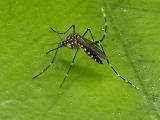What started in December as a rural, sylviatic (jungle-related) yellow fever outbreak in Brazil is now pushing toward urban areas, which could pose a risk of international spread to US states and territories, similar to what happened with Zika virus, federal infectious disease experts warned yesterday.
In a perspective piece in the New England Journal of Medicine, Anthony Fauci, MD, director of the US National Institute of Allergy and Infectious Diseases, and his associate Catharine Paules, MD, said so far there is no evidence that Aedes aegypti mosquitoes are involved in Brazil's yellow fever outbreak, a hallmark of urban outbreaks. They added, however, that affected areas are close to major cities where residents aren't routinely vaccinated.
"This proximity raises concern that, for the first time in decades, urban transmission of yellow fever will occur in Brazil," Fauci and Paules wrote.
1,500 suspected cases in Brazil
So far confirmed cases have been reported in three of Brazil's states: Minas Gerais, Espirito Santo, and Sao Paulo. The largest portion of the cases had been reported from Minas Gerais, but infections there have declined over the past 4 weeks, with cases increasing in Espirito Santo, where the disease is expanding toward the urban areas that Fauci and Paules noted.
Earlier this week the World Health Organization said that the outbreak was expanding toward Brazil's Atlantic coast to an area that hadn't been at risk for yellow fever before. It announced that all of Espirito Santo is now considered at risk and that vaccination is now recommended for any travelers visiting the area.
The Pan American Health Organization (PAHO) said in its latest outbreak update today that confirmed cases in Espirito Santo have been reported in the cities of Serra and Aracruz, both close to large urban areas. Also, outbreaks in monkeys and suspected cases have been reported in Vitoria, and, taken together, the factors pose a high risk of a change in the transmission cycle, PAHO said.
Overall, since December Brazil has reported 1,500 suspected cases, 371 of them confirmed, 163 ruled out, and 966 still under investigation. So far, 241 deaths have been reported, 127 of them with a confirmed connection to yellow fever. The number of suspected cases is up by 132 from a week ago.
Following in Zika's footsteps?
Fauci and Paules said dengue, chikungunya, and Zika have shown how viruses carried by Aedes mosquitoes can burn through populations that have little preexisting immunity and can spread more widely owing to human travel.
They said yellow fever outbreaks in the continental United States aren't likely because mosquito densities are low and the exposure risk is limited. With Zika, however, travel-related cases could seed the virus to Aedes aegypti populations and result in brief local transmission in warmer regions such as the Gulf Coast, where the mosquitos are found. They also warned that yellow fever outbreaks could occur in US territories.
The recent yellow fever outbreak in Angola and the Democratic Republic of the Congo underscored the risk of international spread and exhausted the world's emergency vaccine stockpile, the two noted, adding that early identification, public health preparedness, and prevention strategies are critical.
But they said identifying suspected yellow fever cases early might be difficult in countries like the United States, where many doctors have never seen a case and know little about the symptom profile and the course of the illness, which plays out in three stages: infection, remission, and intoxication.
Yellow fever is the most severe arbovirus to circulate in the Americas, and Fauci and Paules urged physicians to have a high index of suspicion for the disease, especially in travelers returning from affected regions.
See also:
Mar 8 N Engl J Med perspective
Mar 9 PAHO update


















